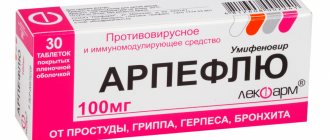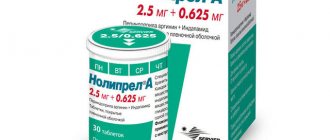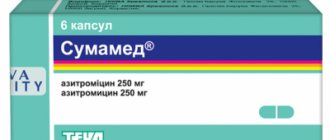Pharmacodynamics and pharmacokinetics
Pharmacodynamics
Is ofloxacin an antibiotic or not? This is not an antibiotic , but an antibacterial agent from the group of fluorinated quinolones , which is not the same thing. Differs from antibiotics in structure and origin. Fluoroquinolones have no analogues in nature, and antibiotics are products of natural origin.
The bactericidal effect is associated with inhibition of DNA gyrase, which leads to disruption of DNA synthesis and cell division, changes in the cell wall, cytoplasm and cell death. The inclusion of a fluorine atom in the quinoline molecule changed the spectrum of antibacterial action - it has expanded significantly and also includes microorganisms that are resistant to antibiotics and strains that produce beta-lactamases.
Gram-positive and gram-negative microorganisms, as well as chlamydia , ureaplasma , mycoplasma , gardnerella . Suppresses the growth of Mycobacterium tuberculosis . Does not affect Treponema pallidum. Microflora resistance develops slowly. A pronounced post-antibiotic effect is characteristic.
Pharmacokinetics
Absorption after oral administration is good. Bioavailability 96%. A small part of the drug binds to proteins. The maximum concentration is determined after 1 hour. It is well distributed in tissues, organs and fluids, penetrates into cells. Significant concentrations are observed in saliva, sputum, lung, myocardium, intestinal mucosa, bones, prostate tissue, female genital organs, skin and fiber.
Penetrates well through all barriers and into the cerebrospinal fluid. About 5% of the dose is biotransformed in the liver. The half-life is 6-7 hours. With repeated administration, cumulation is not pronounced. It is excreted by the kidneys (80-90% of the dose) and a small part with bile. In renal failure, T1/2 increases. With liver failure, excretion may also slow down.
Ofloxacin-solopharm eye/ear drops 0.3% 5ml fl cap. 1 PC
Pharmacological group:
Antimicrobial agent - fluoroquinolone.
Pharmacodynamics:
A broad-spectrum antimicrobial agent from the group of fluoroquinolones, acts on the bacterial enzyme DNA gyrase, which ensures supercoiling and, thus, the stability of DNA bacteria (destabilization of DNA chains leads to their death). Has a bactericidal effect. Active against microorganisms producing beta-lactamases and fast-growing atypical mycobacteria.
Sensitive: Staphylococcus aureus (including strains), Staphylococcus epidermidis, Streptococcus pneumoniae, Streptococcus pyogenes, Enterococcus faecalis, Corynebacterium spp., Micrococcus spp., Bacillus spp., Enterobacteriaceae (Escherichia coli, Citrobacter, Enterobacter spp., Klebsiela spp., Proteus spp. ., Salmonella spp., Serratia spp., Shigella spp.), Pseudomonas aeruginosa and Pseudomonas species, Haemophilus influenza, Haemophilus ducreyi, Branhamella catarhalis, Neisseria gonorrhoeae, Neisseria menengitidis, Acinetobacter spp., Campylobacter spp., Gardenerella vaginalis, Helicobacter pylori, Brucella spp. The drug also exhibits activity against Chlamydia trachomatis, Chlamydia pneumoniae, Mycoplasma pneumoniae and some other mycoplasmas. Clostridium species, Bacteroides species and Peptococcus species are resistant. Resistance of Pseudomonas aeruginosa ranges between 15-20%, and resistance of Staphylococcus aureus between 5-10%.
Pharmacokinetics:
4 hours after topical application, the average concentration of ofloxacin in tear fluid exceeds 2 μg/ml (the minimum concentration required to inhibit in vitro growth by 90% for the most common strains of infectious eye diseases - MIC90). Instillation of ofloxacin into the ear in the case of an intact eardrum is accompanied by minimal absorption in the middle ear. However, the absorption of ofloxacin is enhanced by perforations of the tympanic membrane. After instillation of a 0.3% solution of ofloxacin in adults with perforation of the tympanic membrane, the maximum concentration in the blood serum is 10 ng/ml. The maximum concentration of ofloxacin in the blood serum after 10 days of regular topical use is 1000 times less than when using standard doses of ofloxacin orally.
Indications for use
- bronchitis , pneumonia ;
- diseases of ENT organs ( pharyngitis , sinusitis , otitis media , laryngitis );
- diseases of the kidneys and urinary tract ( pyelonephritis , urethritis , cystitis );
- infections of the skin, soft tissues, bones;
- endometritis , salpingitis , parametritis , oophoritis , cervicitis , colpitis , prostatitis , epididymitis , orchitis ;
- gonorrhea , chlamydia ;
- corneal ulcers, blepharitis , conjunctivitis , keratitis , stye , chlamydial eye lesions, prevention of infection after injuries and operations (for ointment).
Contraindications
- age under 18 years;
- increased sensitivity;
- pregnancy;
- breast-feeding;
- epilepsy or increased convulsive readiness after traumatic brain injury, cerebrovascular accidents and other diseases of the central nervous system;
- previously noted tendon damage after taking fluoroquinolones ;
- peripheral neuropathy;
- lactose intolerance ;
- age up to 1 year (for ointment).
It is prescribed with caution for organic diseases of the brain, myasthenia gravis , severe dysfunction of the liver and kidneys, hepatic porphyria , heart failure , diabetes mellitus , myocardial infarction , paroxysmal ventricular tachycardia , bradycardia , and in old age.
Side effects
Most common adverse reactions:
- nausea , loss of appetite;
- vomit;
- diarrhea , abdominal pain;
- flatulence.
Less common and very rare adverse reactions:
- transaminase activity , cholestatic jaundice ;
- hepatitis , hemorrhagic colitis , pseudomembranous colitis ;
- headache , dizziness ;
- anxiety, irritability;
- insomnia , intense dreams;
- anxiety, phobias;
- depression;
- tremor , convulsions;
- paresthesia of the limbs , peripheral neuropathy;
- conjunctivitis;
- tinnitus, hearing loss ;
- color vision disturbance, double vision;
- taste disturbances;
- tendonitis , myalgia , arthralgia , pain in the extremities;
- tendon rupture;
- palpitations, ventricular arrhythmia , hypertension ;
- dry cough , shortness of breath , bronchospasm ;
- petechiae;
- leukopenia , anemia , thrombocytopenia ;
- renal dysfunction, dysuria , urinary retention ;
- rash, itchy skin, urticaria ;
- intestinal dysbiosis.
Ofloxacin (Ofloxacinum)
From the gastrointestinal tract:
nausea, vomiting, diarrhea, loss of appetite, flatulence, gastrointestinal dysfunction, liver necrosis, jaundice, hepatitis, pseudomembranous colitis, disorders of the oral mucosa, heartburn, increased bilirubin levels in the blood serum, abdominal pain and cramps, dry mouth, constipation, liver dysfunction, intestinal perforation, gastrointestinal bleeding, increased activity of liver enzymes, including gamma-glutamyltransferase and lactate dehydrogenase.
Allergic reactions:
itching, urticaria, allergic pneumonitis, erythema multiforme, erythema nodosum, toxic epidermal necrolysis, skin rash, angioedema, vasculitis, anaphylactic shock, Stevens-Johnson syndrome, exfoliative dermatitis, conjunctivitis.
From the nervous system:
insomnia, fatigue, drowsiness, seizures, cognitive changes, pathological dreams, hallucinations, syncope, confusion, suicidal thoughts or attempts, psychotic reactions, phobia, aggressiveness, peripheral neuropathy, coordination problems, speech impairment, dizziness, nervousness, anxiety, depression, euphoria, paresthesia, tremor, nystagmus, disorientation, paranoia, agitation, emotional lability, ataxia, exacerbation of extrapyramidal disorders.
From the reproductive system:
itching in the external genital area in women, vaginal discharge, irritation, pain and rash in the genital area in women, menorrhagia, vaginal candidiasis, vaginitis, burning sensation, dysmenorrhea, metrorrhagia.
From the urinary system:
dysuria, urinary retention, polyuria, kidney stone formation, nephritis, albuminuria, increased urination, anuria, renal failure, hematuria, candiduria.
From the cardiovascular system:
cardiac arrest, arterial hypertension, palpitation, cerebral thrombosis, tachycardia, edema, arterial hypotension, vasodilation, pulmonary edema.
From the side of metabolism:
thirst, hyper- or hypoglycemia, increased serum triglycerides, cholesterol, potassium, decreased body weight, acidosis.
From the musculoskeletal system:
arthralgia, tendinitis, exacerbation of myasthenia gravis, myalgia, muscle weakness.
Dermatological reactions:
photosensitivity, vesiculobullous rashes, hyperpigmentation.
From the senses:
hearing impairment, diplopia, nystagmus, disturbances of taste, smell, tinnitus, impaired clarity of visual perception, photophobia.
From the hematopoietic system:
anemia, agranulocytosis, reversible inhibition of bone marrow hematopoiesis, thrombocytopenic purpura, ecchymosis, bleeding, pancytopenia, leukopenia, thrombocytopenia, petechiae, increased prothrombin time.
From the respiratory system:
cough, respiratory arrest, bronchospasm, nasal discharge, dyspnea, stridor.
Other:
chest pain, increased body temperature, asthenia, general malaise, increased sweating, pharyngitis, body pain, chills, nosebleeds.
Instructions for use of Ofloxacin (Method and dosage)
Ofloxacin ointment, instructions for use
Apply 1-1.5 cm of ointment to the lower eyelid 3 times a day. In the presence of chlamydial eye lesions - 5 times a day. Treatment is carried out for no more than 2 weeks. When using several drugs simultaneously, the ointment is used last.
Ofloxacin tablets, instructions for use
The tablets are taken orally, whole, before or during meals. The dose is selected depending on the severity of the infection, liver and kidney function. The usual dose is 200-600 mg per day, divided into 2 doses. For severe infections and if the patient is overweight, the daily dose is increased to 800 mg. For gonorrhea , 400 mg is prescribed in one dose, once, in the first half of the day.
It is prescribed to children for health reasons, if there is no replacement with other means. The daily dose is 7.5 mg per kg of weight.
For patients with impaired renal function, the dosage regimen is adjusted. In patients with severe liver dysfunction, the daily dose should be no more than 400 mg. The duration of treatment is determined by the severity of the disease. Treatment is continued for another 3 days after the temperature has normalized or after laboratory tests confirming the eradication of the microorganism . Most often, the duration of treatment is 7-10 days, for salmonellosis - 7 days, for urinary tract infections - up to 5 days. Treatment should not last more than 2 months. In the treatment of certain diseases, Ofloxacin is first prescribed intravenously 2 times a day, followed by oral administration.
Drops with the active substance ofloxacin are available under the names Dancil , Floxal , Uniflox . See instructions for use of these drugs.
Ofloxacin, 400 mg, film-coated tablets, 10 pcs.
It is not the drug of choice for pneumonia caused by pneumococci. Not indicated for the treatment of acute tonsillitis.
It is not recommended to be exposed to sunlight or exposure to UV rays (mercury-quartz lamps, solarium).
To prevent urine hyperconcentration and subsequent crystalluria, adequate hydration is recommended during treatment.
The appearance of diarrhea, especially severe, persistent and/or bloody diarrhea, during or after treatment with ofloxacin may be a manifestation of pseudomembranous colitis. If pseudomembranous colitis is suspected, treatment with ofloxacin should be discontinued immediately and appropriate specific antibacterial therapy (eg, oral vancomycin, oral teicoplanin, or metronidazole) should be instituted without delay. Drugs that inhibit intestinal motility are contraindicated.
If side effects from the central nervous system or allergic reactions occur, discontinuation of the drug is necessary.
Rarely, tendinitis can lead to tendon rupture (mostly the Achilles tendon), especially in older patients. If signs of tendinitis occur, you should immediately stop treatment, immobilize the Achilles tendon and consult an orthopedist.
During the treatment period, ethanol should not be consumed.
When using the drug, women are not recommended to use sanitary tampons due to the increased risk of developing thrush.
During treatment, the course of myasthenia gravis may worsen and attacks of porphyria may become more frequent.
May lead to false negative results in the bacteriological diagnosis of tuberculosis (prevents the isolation of Mycobacterium tuberculosis).
In patients with impaired liver function, monitoring of plasma concentrations of ofloxacin is necessary. In severe liver failure, the risk of toxic effects increases (reducing dose adjustment is required).
In patients using fluoroquinolones, including ofloxacin, cases of sensory and sensorimotor axonal polyneuropathy affecting small and (or) large axons and leading to paresthesia and hypoesthesia have been reported. dysesthesia and weakness. Symptoms may appear soon after starting use and may be irreversible. If the patient develops symptoms of neuropathy, including pain, burning, tingling, numbness and/or weakness or other sensory disturbances, including touch, pain, temperature, vibration and position sense, ofloxacin should be discontinued immediately.
Taking ofloxacin, especially long-term, can cause a secondary infection associated with the growth of drug-resistant microorganisms. Re-evaluation of the patient's condition is necessary.
Impact on the ability to drive vehicles and operate machinery
During the treatment period, care must be taken when driving vehicles and engaging in other potentially hazardous activities that require increased concentration and speed of psychomotor reactions. If undesirable effects such as dizziness or drowsiness occur, you should refrain from performing these activities.
Interaction
When prescribing sucralfate , antacids and drugs containing aluminum, zinc, magnesium or iron, the absorption of ofloxacin . There is an increase in the effectiveness of indirect anticoagulants when taken with this drug. Control of the coagulation system is necessary.
The risk of neurotoxic effects and convulsive activity increases with the simultaneous administration of NSAIDs, nitroimidazole and methylxanthines .
When used with Theophylline, its clearance decreases and its half-life increases.
The simultaneous use of hypoglycemic agents may lead to hypo- or hyperglycemic states.
When used with Cyclosporine, an increase in its concentration in the blood and half-life is observed.
Probenecid , Furosemide , Cimetidine and Methotrexate reduce the tubular secretion of the active substance, which leads to an increase in its concentration in the blood plasma.
A sharp decrease in blood pressure is possible when using barbiturates and antihypertensive drugs .
When used with glucocorticosteroids, there is a risk of tendon rupture.
It is possible to prolong the QT interval when using antipsychotics, antiarrhythmic drugs, tricyclic antidepressants, macrolides, imidazole derivatives, astemizole , terfenadine , ebastine .
The use of carbonic anhydrase inhibitors, sodium bicarbonate and citrates, which alkalinize the urine, increases the risk of crystalluria and nephrotoxicity.
Ofloxacin film-coated tablets 400 mg No. 10
Release form
Due to the fact that ofloxacin is excreted mainly through the kidneys, dosage adjustment of ofloxacin is necessary in patients with renal failure.
Due to the risk of photosensitivity, exposure to sunlight and ultraviolet rays should be avoided. The appearance of diarrhea, especially severe, persistent and/or bloody diarrhea, during or after treatment with ofloxacin may be a manifestation of pseudomembranous colitis. If the development of pseudomembranous colitis is suspected, treatment with ofloxacin should be stopped immediately and appropriate specific antibacterial therapy should be prescribed without delay. In this clinical situation, drugs that suppress intestinal motility are contraindicated. Like other quinolones, ofloxacin should be administered with extreme caution to patients predisposed to the development of epileptic seizures (patients with a history of damage to the central nervous system, taking fenbufen and similar non-steroidal anti-inflammatory drugs or drugs that lower the seizure threshold, for example, theophylline).
Tendonitis, which is very rare, can sometimes lead to tendon rupture, predominantly the Achilles tendon, especially in older patients. If signs of tendonitis (inflammation of the tendon) appear, it is recommended to immediately stop treatment, immobilize the Achilles tendon and consult an orthopedic surgeon.
Some caution is warranted when taking fluoroquinolones, including ofloxacin, in patients with known risk factors for QT prolongation, such as:
-elderly age,
- uncorrectable electrolyte imbalance (for example, hypokalemia, hypomagnesemia), - congenital prolongation of the QT interval,
- diseases of the cardiovascular system (heart failure, myocardial infarction, bradycardia),
- simultaneous use of drugs that prolong the QT interval (classes IA and III antiarthmic drugs, tricyclic antidepressants, macrolides).
Ofloxacin may worsen myasthenia gravis. Possible increased frequency of porphyria attacks. During treatment with ofloxacin, false-positive results may occur when determining opiates and porphyrins in urine.
Ofloxacin interferes with the isolation of Mycobacterium tuberculosis, leading to false-negative results in the bacteriological diagnosis of tuberculosis. It is also not recommended to consume ethanol during the treatment period. Ofloxacin is not the drug of choice for pneumonia caused by pneumococci. Not indicated for the treatment of acute tonsillitis.
Ofloxacin analogs
Level 4 ATX code matches:
Siflox
Hyleflox
Leflobakt
Lefoccin
Gatifloxacin
Faktiv
Tigeron
Lebel
Zanotsin
Lomefloxacin
Eleflox
Lomflox
Pefloxacin
Tsiprobay
Sparflo
Tariwid
Zoflox
Abaktal
Moxifloxacin
Levofloxacin
Tablet preparations: Zanotsin , Zoflox , Ofloxin .
Solutions for infusions: Oflo , Tarivid , Ofloxabol .
An analogue of Ofloxacin, produced in the form of an eye ointment - Floxal , in the form of eye/ear drops - Dancil , Uniflox .
Reviews about Ofloxacin
Fluoroquinolones occupy a leading place among antimicrobial agents and are considered as an alternative to highly active antibiotics in the treatment of severe infections. Currently, the monofluorinated representative of the second generation, ofloxacin .
The advantage of this drug over other fluoroquinolones is its very high bioavailability, as well as the slowly and rarely developing resistance of microorganisms to it.
Given its high activity against STI pathogens, this drug is widely used in dermatovenerology in the treatment of STIs: urogenital chlamydia , gonorrhea , gonorrheal-chlamydial, mycoplasma and ureaplasma infections. Eradication of chlamydia is observed in 81-100% of cases and it is considered the most effective of all fluoroquinolones. This is evidenced by reviews of Ofloxacin:
- “... I took this drug and treated mycoplasma and ureaplasma. Effective";
- “... It helped me, I drank it for cystitis, there were no side effects. The drug is inexpensive and effective.”
A wide spectrum of action, good penetration into the tissues of the genital organs, urinary system, prostate secretions, long-term preservation of concentrations in the lesion determines its use for urological and gynecological diseases. Thus, there are reviews that taking this remedy for 3 days has shown high effectiveness for recurrent cystitis in women. It was prescribed for prophylactic purposes after diathermocoagulation of cervical erosions after the introduction of intrauterine contraceptives , after abortions , and was successfully used for prostatitis and epididymitis .
Not being an antibiotic, it does not affect the vaginal and intestinal flora and does not cause dysbacteriosis . According to patients, this drug is poorly tolerated. Most often, side effects were observed from the gastrointestinal tract, less often - from the central nervous system and skin allergic reactions, and very rarely - transient changes in liver test parameters. The drug does not have hepato-, nephro- and ototoxic effects.
- “... there was nausea, my stomach was churning, there was no appetite”;
- “... I felt very sick, I couldn’t eat anything, but I finished the course of treatment”;
- “... After taking it, insomnia appeared. I suspect it’s from the drug, since I slept well before”;
- “...felt hot and cold in a sweat, and panic appeared.”
Many patients with conjunctivitis , blepharitis and keratitis were prescribed eye drops with the active ingredient ofloxacin ( Uniflox , Floxal , Dancil ), reviews of which were positive. Patients used them 4-5 times a day for blepharitis and conjunctivitis and noted significant improvement within 2-3 days. Due to the high bioavailability of the active substance, drops can also be used for deeper lesions - uveitis , scleritis and iridocyclitis .
Ophthalmology
For empirical prescription of antibacterial therapy for infectious and inflammatory eye diseases, broad-spectrum drugs with a rapid bactericidal effect are suitable without waiting for sensitivity culture results. According to the recommendations of the American Academy of Ophthalmology, fluoroquinolones can be prescribed empirically when the causative agent of the infectious process is not identified (Fig. 1) [2].
Antibiotic use for bacterial keratitis Not determined Gram-positive cocci Gram-negative cocci Gram-positive rods Gram-negative rods Fluoroquinolones* Cefazolin Vancomycin Tobramycin Ceftriaxone Gentamicin Amikacin Trimethoprim Azithromycin
Topical antibiotic eye drops are capable of reaching high tissue levels and are the preferred method of treatment in most cases. Current American Academy of Ophthalmology guidelines list ofloxacin 0.3% as the recommended antibiotic for the treatment of bacterial keratitis. The Food and Drug Administration (FDA, USA) has approved ofloxacin 0.3%, ciprofloxacin 0.3%, and levofloxacin 1.5% for the treatment of bacterial keratitis. It has been noted that monotherapy using fluoroquinolones is as effective as combination therapy using other antibiotics. As experts note, according to some studies, the use of eye drops of ofloxacin 0.3% and levofloxacin 1.5% for bacterial keratitis showed similar effectiveness in terms of re-epithelialization and the absence of progression of the infiltrate.
A representative of the second generation fluoroquinolones is ofloxacin, produced in two dosage forms: drops and as an eye ointment. The results of numerous studies confirm the relevance of its use and the high degree of influence on gram-positive and gram-negative flora. According to the multicenter eight-year observational study ARMOR (2009–2016), in vitro
among strains of
S. pneumoniae, H. influenza and P. aeruginosa,
sensitivity to various fluoroquinolones was about 92–99%, while the minimum inhibitory concentration (MIC90) for ofloxacin was comparable to that of representatives of fluoroquinolones of the III–IV generation [1].
Thus, drawing attention to many years of experience in the use of ofloxacin in ophthalmology, the antibiotic appears in modern international recommendations and demonstrates its effectiveness as a treatment for infectious diseases of the anterior segment of the eye.
Blepharitis is one of the most common eye diseases. As has been shown in animal studies, ofloxacin (ointment) creates a high concentration of an antibacterial substance in the tissues of the eyelid [4]. Interestingly, in the study, the pharmacokinetics of levofloxacin 1.5% eye drops and 0.3% ofloxacin ophthalmic ointment were markedly different: the Cmax value of ofloxacin in the eyelids was higher than that of levofloxacin, and remained at a higher level for 24 hours (Fig. .2). A possible explanation for the observed effect may be the fact that part of the ointment was localized along the edge of the eyelid. The higher maximum concentration of ofloxacin ointment could be due to high absorption across the eyelid margin, such as through the eyelash follicles.
Concentration, mg/g 0.01 0.1 1 10 100 Tissue of the eyelid Time, h Ofloxacin Levofloxacin Such long-term preservation of a high concentration of the drug contributes to the antibacterial effect [4]. The death of bacteria as a result of exposure to fluoroquinolones directly depends on the concentration of the drug. The higher the concentration, the faster the bactericidal effect is achieved [3].
Thus, ofloxacin ophthalmic ointment 0.3% is a dosage form for effective delivery of the substance to the tissues of the eyelid.
Ofloxacin 0.3% in the form of eye drops and ointment is included in the national guidelines for the treatment of infectious blepharitis, conjunctivitis and keratitis [5, 6]. In the clinical guidelines for the treatment of bacterial conjunctivitis (2021), the “treatment” section provides information: “In addition to antibacterial therapy, all patients are recommended to use a fluoroquinolone in the form of an eye ointment – ofloxacin...” [7].
In conclusion, ofloxacin has been proven effective and safe in various ophthalmic studies over the years and meets the requirements for modern topical antimicrobial agents.
Ofloxacin price, where to buy
You can purchase the drug at any pharmacy. The cost depends on the manufacturer. The price of Ofloxacin in tablets of 200 mg produced in Russia (Ozon, Makiz Pharma, Sintez OJSC) ranges from 26 rubles. up to 30 rub. for 10 tablets, and the cost of tablets 400 mg No. 10 is from 53 to 59 rubles. Ofloxacin Teva, produced only in 200 mg tablets, is more expensive - 163-180 rubles. Eye ointment (Kurgan OJSC Sintez) costs from 38 to 64 rubles. in different pharmacies.
The price of Ofloxacin in Ukraine is 11-14 UAH. (tablets), 35-40 UAH. (solution for infusion).
- Online pharmacies in RussiaRussia
- Online pharmacies in UkraineUkraine
- Online pharmacies in KazakhstanKazakhstan
ZdravCity
- Ciprofloxacin tablets p.p.o.
250 mg 10 pcs. Ozon LLC 24 rub. order - Levofloxacin-Teva tablets p.p.o. 500 mg 14 pcs. Teva Pharmaceutical Enterprises Ltd.
RUR 694 order
- Levofloxacin tablets p.p.o. 500 mg 10 pcs. Ozone LLC
RUB 374 order
- Levofloxacin tablets p.p.o. 500 mg 10 pcs. Pharmstandard-Leksredstva OJSC
420 rub. order
- Ofloxacin tablets p.p.o. 200 mg 10 pcs. Ozone LLC
51 RUR order
Pharmacy Dialogue
- Ofloxacin (tablet p/o 200 mg No. 10) Teva
184 RUR order
- Ciprofloxacin (tab.p.pl/vol. 500 mg No. 10) Ozone LLC
40 rub. order
- Levofloxacin-Teva tablets 500 mg No. 7Teva Pharmaceutical
RUB 331 order
- Levofloxacin (dose solution 5 mg/ml, 100 ml bottle No. 1) Alium PFC
RUB 225 order
- Levofloxacin (tab.p.pl/vol.500mg No. 5)Vertex
RUB 317 order
show more
Pharmacy24
- Ofloxacin-Darnitsa 0.2 No. 10 tablets PrAT" Pharmaceutical company "Darnitsa", Ukraine
19 UAH. order - Ofloxacin 0.2 g No. 10 tablets AT "Lekhim-Kharkiv", Ukraine
19 UAH order
- Ofloxacin 200 mg 100 ml No. 1 solution Eurolife Healthcare Pvt. Ltd., India
45 UAH order
- Ciprofloxacin 0.2% 100 ml solution
30 UAH order
- Ciprofloxacin 0.25 No. 10 tablets PrAT "Technolog", Uman, Cherkasy region, Ukraine
15 UAH order
PaniPharmacy
- Enrofloxacin-50 100ml Ukraine, Kharkov-Product
82 UAH order
- LEVOFLOXACIN tablets Levofloxacin film-coated tablets 500 mg No. 10 Ukraine, Health LLC
145 UAH order
- Ciprofloxacin infusion Ciprofloxacin infusion solution 0.2% 100ml Ukraine, Novofarm-Biosintez LLC
18 UAH order
- Ciprofloxacin infusion Ciprofloxacin infusion solution 0.2% 100ml Ukraine, Yuria-Pharm LLC
37 UAH order
- LEVOFLOXACIN tablets Levofloxacin film-coated tablets 500 mg No. 10 Ukraine, Tekhnolog ChAO
122 UAH order
show more




